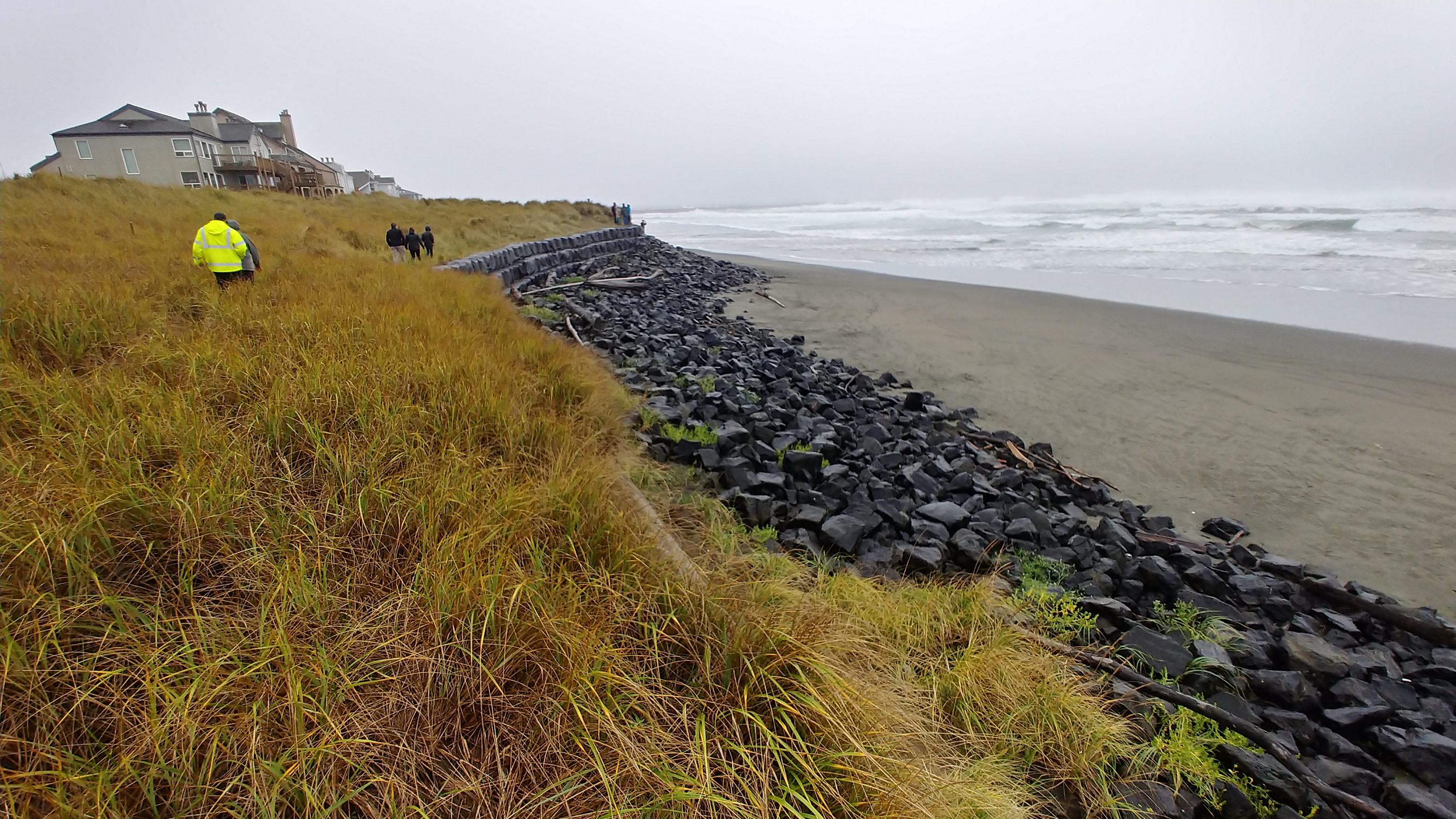
In late October, the four coastal Marine Resources Committees (MRCs) gathered in Ocean Shores for the 2018 MRC Summit. This marked the ninth year of the event and was hosted by the Grays Harbor County MRC. Those who attend the annual gathering learn about the most pressing marine issues on the Washington coast, discuss how the MRCs can be more effective at achieving their missions, share lessons learned, and develop lasting relationships with their colleagues from different geographies.
As is typical of MRC Summits, it began with a Thursday afternoon field trip highlighting a local issue. That issue was coastal erosion. The tour was led by Crystal Dingler, the mayor of Ocean Shores, and Nick Bird, the city’s Public Works Director. Naturally, it was cold, windy, and down-pouring as the field trip began! The first stop was near Damon Point, where Nick showed us the tide gate that separates the freshwater canals from the marine waters of Grays Harbor. As it was an above average high tide, it was very evident that the gate was the last line of defense from a serious episode of saltwater intrusion. The group then crossed the street and observed the dramatic erosion that has occured at Damon Point. This area has been hit with numerous powerful storms in years past, resulting in the recent loss of a road, a parking area and a public restroom.
Next, the group traveled to the jetty south of town (referred to as the north jetty because it’s on the north side of the harbor). Here Nick and Mayor Dingler talked about how the jetty needs maintenance in order to manage sediment properly. An example of why that’s important was just a couple hundred feet north: a handful of properties that have lost beach and dunes and now sit precariously close the the ocean. It has been an area of concern for several years and many techniques have been used, including using “geotubes,” fencing to trap sand, and most recently, hard rock to prevent erosion. At this point, everyone was wet and cold so we wrapped up the tour.
That evening, a social hour was hosted at The Gallery of Ocean Shores. There, MRC Summit attendees schmoozed with each other as they feasted on oysters, clams, and mussels (thanks to Taylor Shellfish!). It was also a stop for Surfrider’s Surfboard Tour, where local business owners had the opportunity to sign the surfboard, signaling their opposition to offshore oil drilling and exploration.
Friday morning began with updates from all of the MRC coordinators, followed by a discussion with staff from the Washington Department of Fish and Wildlife about MRC funding, priorities, and strategic planning. That afternoon, the agenda shifted to coastal resiliency and featured several prominent experts. First, George Kaminsky gave an excellent presentation summarizing coastal sediment processes and his research monitoring beach erosion and accretion on the Washington coast. Peter Ruggiero then shared the results of the Grays Harbor Coastal Futures project that he and his team completed earlier this year. Next, Kelsey Moldenke provided an overview of the Quinault Indian Nation’s plan to move the village of Taholah to higher ground to avoid the hazards of coastal flooding and a potential tsunami. With all the information fresh on everyone’s mind, Bobbak Talebi then facilitated a discussion about priorities and goals for the emerging coastal resiliency effort that the Washington Coast Marine Advisory Council is undertaking. The final activity of the day was a group dinner at Galway Bay Irish Pub.
The Summit continued Saturday morning and kicked off with an economic focus. First up, Kevin Decker shared recent trends of tourism on the Washington coast. Following that, Steve Shively educated the group on the very successful Olympic Culinary Loop program that he coordinates. Those presentations inspired an engaging discussion about the challenges coastal restaurants face if they want to offer local food sources. Julia Sanders then provided an overview of the carbon policy details of Initiative 1631, which was unfortunately defeated days later in the general election. Next, Jenny Waddell gave an engaging overview of research activities within the Olympic Coast National Marine Sanctuary. Lastly, the Surfrider Leadership Academy cohort facilitated a group discussion about their My Coast, My Community video competition and how it could be improved.
With that, we concluded another very successful MRC Summit! If you’re interested, the agenda and most presentations are available to view on the MRC Summit event page (simply click on the titles). And also make sure to check out the press coverage from The North Coast News. Next year, the Summit will migrate up the coast, where the North Coast MRC will play host.
Lastly, we would like to thank our sponsors who made this year’s Summit possible: Friends of Grays Harbor, Ocean Gold, Pacific Seafood, Englund Marine and Industrial Supply, Washington Sea Grant, WeFish, Bank of America, Taylor Shellfish, The Nature Conservancy, and Northwest Fund for the Environment.




